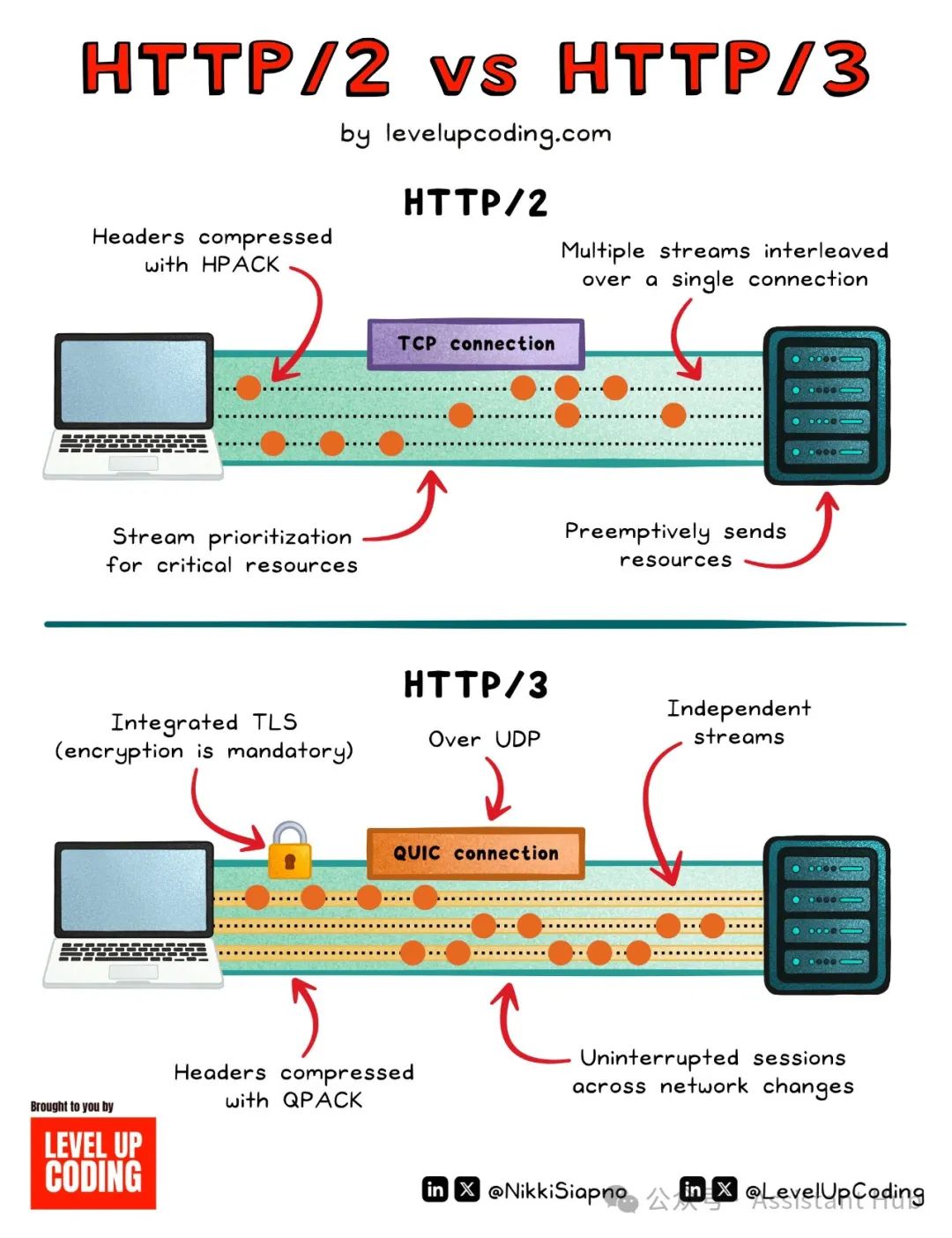Technical Comparison of HTTP/2 vs HTTP/3 🚀
The HTTP protocol is an essential foundation for modern web communication. As network demands have evolved, the HTTP protocol has progressed from its earlier versions to HTTP/2 and the latest HTTP/3. This article will provide a detailed analysis of the technical differences between these two versions through comparative illustrations, helping you fully understand how they optimize network performance.

Technical Features of HTTP/2 🌐
1. Based on TCP Connection
HTTP/2 relies on TCP (Transmission Control Protocol) as its underlying transport protocol. TCP provides reliable data transmission, but its handshake process and congestion control mechanisms can lead to latency issues, especially in high packet loss environments.
2. Multiplexing Technology
HTTP/2 allows multiple streams to be transmitted concurrently over a single TCP connection. This multiplexing mechanism addresses the “Head-of-Line Blocking” issue present in HTTP/1.1, improving transmission efficiency.
3. HPACK Header Compression
To reduce data redundancy, HTTP/2 uses the HPACK algorithm to compress HTTP headers. This significantly lowers bandwidth consumption, especially in scenarios with a large number of repeated requests.
4. Resource Priority Setting
HTTP/2 allows for the prioritization of different resources to ensure that critical resources (such as CSS and JavaScript) are loaded first. This is crucial for optimizing page load speed.
5. Server Push
The server can proactively send resources to the client without waiting for the client to request them. This mechanism speeds up resource loading but may lead to resource wastage if the client already has the corresponding resources cached.
Technical Features of HTTP/3 🔥
1. Based on UDP and QUIC Protocol
HTTP/3 completely abandons TCP in favor of using UDP (User Datagram Protocol) as its underlying protocol, implementing reliable transmission through QUIC (Quick UDP Internet Connections). The QUIC protocol integrates TLS encryption and flow control features, making the handshake process faster while significantly reducing latency.
2. Independent Stream Mechanism
Unlike HTTP/2, each data stream in HTTP/3 is independent. This means that even if one stream encounters an error, it will not affect the transmission of other streams, completely resolving the head-of-line blocking issue.
3. QPACK Header Compression
HTTP/3 uses the QPACK algorithm for header compression, which is an optimized version for QUIC, further enhancing transmission efficiency while reducing latency.
4. Mandatory Encryption (Integrated TLS)
In HTTP/3, TLS encryption is mandatory rather than optional. This ensures the security of all communications while simplifying protocol design.
5. Fast Switching Across Networks
QUIC supports connection migration, allowing devices to maintain connections without interruption when switching networks (e.g., from Wi-Fi to mobile networks). This is particularly important for mobile devices.
Core Differences Comparison Table 🆚
| Feature | HTTP/2 | HTTP/3 |
| Underlying Protocol | TCP | UDP + QUIC |
| Data Stream Mechanism | Multiplexing (Shared Single Connection) | Independent Streams |
| Head-of-Line Blocking Issue | Partially Resolved | Completely Resolved |
| Header Compression Algorithm | HPACK | QPACK |
| Encryption Method | Optional TLS | Mandatory TLS |
| Server Push | Supported | Supported |
| Network Switching Support | Not Supported | Supported (QUIC Connection Migration) |
Why Choose HTTP/3? 📈
Although HTTP/2 has significantly improved network performance, it is still affected by inherent limitations of the TCP protocol, such as head-of-line blocking and performance degradation in high packet loss environments. HTTP/3 fundamentally addresses these issues by introducing the QUIC protocol, particularly excelling in high mobility and high packet loss scenarios. Therefore, for modern applications and mobile devices, HTTP/3 is undoubtedly the superior choice.
Conclusion ✨
HTTP/2 and HTTP/3 represent two important stages in the evolution of web technology. HTTP/2 optimized performance through multiplexing and header compression, but its TCP-based design has certain limitations. HTTP/3, by introducing the QUIC protocol, not only further enhances transmission efficiency but also improves security and stability. In the future, as browser and server support for HTTP/3 becomes widespread, it is likely to become the new standard for web communication.
If you are developing web-based applications, consider delving deeper into HTTP/3 and start thinking about how to integrate it into your technology stack!